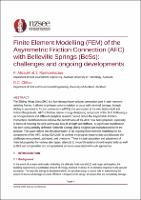| dc.contributor.author | Alizadeh, Fatemeh | |
| dc.contributor.author | Ramhormozian, Shahab | |
| dc.contributor.author | Clifton, G Charles | |
| dc.date.accessioned | 2024-07-01T02:01:23Z | |
| dc.date.available | 2024-07-01T02:01:23Z | |
| dc.date.issued | 2024-04-09 | |
| dc.identifier.uri | https://repo.nzsee.org.nz/xmlui/handle/nzsee/2762 | |
| dc.description.abstract | The Sliding Hinge Joint (SHJ) is a low-damage beam-column connection used in steel moment-resisting frames. It allows large beam-column rotation to occur with minimal damage, through sliding in asymmetric friction connections (AFCs) that are located at the web bottom bolt and bottom flange levels. AFC is friction seismic energy dissipating component of the SHJ. Following a set of experiments and different analytical research carried out on the Asymmetric Friction Connection, modifications to improve the performance of the AFC have been proposed, especially in terms of reducing the post-earthquake loss of strength and stiffness. A significant modification has been using partially deflected Belleville Springs (BeS) designed and manufactured to fit the purpose. This paper delves into the presentation of an ongoing finite element modelling for the components of the AFC, using ABAQUS. It outlines the progress made to date and discusses the challenges encountered, addressed, and overcome. These include adaptation and adjustment of material properties for various steel types, attempts to model threaded and nonthreaded bolts as well as BeS and complexities and computational demands associated with such approaches. | |
| dc.language.iso | en | |
| dc.publisher | New Zealand Society for Earthquake Engineering | |
| dc.relation.ispartofseries | 2024;96 | |
| dc.subject | Seismic performance, risk mitigation and resilience of new and existing structures | |
| dc.title | Finite Element Modelling (FEM) of the Asymmetric Friction Connection (AFC) with Belleville Springs (BeSs): challenges and ongoing developments | |
| dc.type | Article | |

